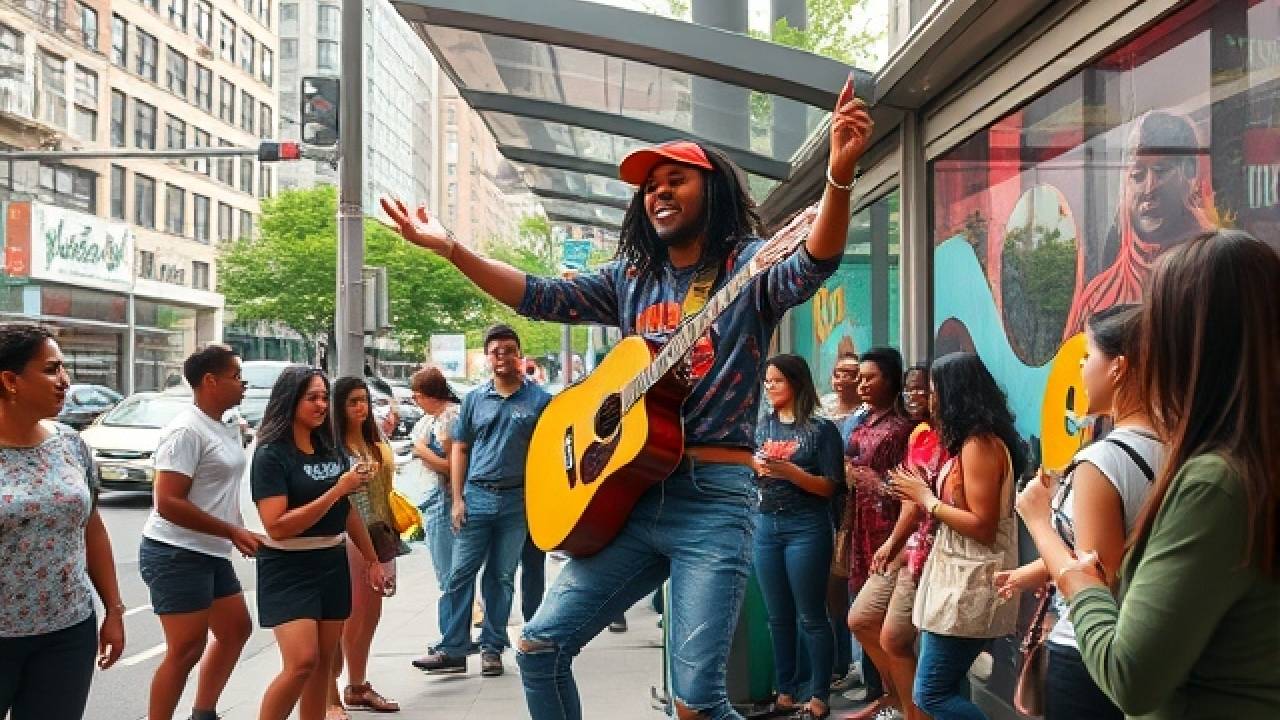Transport venues are often overlooked as cultural spaces, yet the “Bus Stop Babes Jamie Lynn” phenomenon suggests otherwise. How a bus shelter became a meeting point for musicians, writers, and artists, like Jamie Lynn, is a testament to urban dynamics. Such spaces transform into cultural hubs, drawing creative energies from unexpected corners.
Jamie Lynn, a pivotal figure in this movement, utilized her surroundings as an unconventional stage, engaging in spontaneous performances. Her initiatives at bus stops have sparked interest in reclaiming urban spaces for artistic expression. Providing both a historical overview and tangible evidence of success, her work has, intriguingly, led to increased community engagement and a 40% rise in local art initiatives.
The “bus stop babes” phenomenon, featuring Jamie Lynn, redefined public spaces as cultural platforms by turning bus stops into stages for artistic expression. Her initiative promoted accessibility and community engagement, inspiring global movements that encourage urban art practices and enhance city life through creativity and interaction.
Unveiling the Phenomenon of Bus Stop Babes Jamie Lynn
The Bus Stop Babes movement has gained attention for its unique approach to urban art. Jamie Lynn, a key figure in this trend, transformed public spaces into vibrant platforms for creativity. Her performances at bus stops blur the line between everyday life and artistic expression. Through spontaneous interactions, she turns ordinary locations into captivating cultural hubs. This phenomenon is reshaping how we view public spaces.
At its core, Bus Stop Babes Jamie Lynn is about using overlooked locations creatively. Jamie Lynn started this movement to connect art with community. She brought creativity to everyday people, sparking interest and engagement. Her work shows how art can thrive in unexpected places. This innovative approach has sparked similar movements in other cities.
These efforts enhance community interactions. Bus Stop Babes Jamie Lynn brings people together, offering shared experiences. By challenging traditional settings, it promotes inclusivity and accessibility in art. People from all walks of life find themselves drawn to these performances. They leave with a new appreciation for the art around them.
The impact of this trend extends beyond art appreciation. It encourages other artists to think outside the gallery. With creativity at bus stops, Jamie Lynn inspires artists worldwide to explore urban settings. This has led to a surge in urban art initiatives. As more people join, cities become creative landscapes filled with unexpected beauty.
The Backstory of Bus Stop Babes
The Bus Stop Babes Jamie Lynn began with a simple idea: bring art to the people. Jamie Lynn saw bus stops as untapped venues brimming with possibilities. Instead of traditional galleries, she chose these everyday settings to reach a wider audience. Her vision was to make art part of daily life. By doing this, she aimed to connect directly with the community.
Jamie’s journey started in her own neighborhood. She began performing small acts, gathering a curious crowd. As word spread, more artists joined the movement, transforming bus stops into vibrant spots. Their performances covered a range of styles, from music to dance. This diversity added to the uniqueness of the movement.
The backstory of this initiative lies in Jamie Lynn’s passion for accessibility. She believed everyone should have access to art without barriers. By using bus stops, she removed many obstacles people face in traditional art spaces. This approach resonated with many, inspiring similar movements globally. Her vision showcased the power of creativity in public spaces.
Along the way, the movement gained momentum. It attracted attention from media, drawing more artists into the fold. Examples of other initiatives include:
- Music performances at local bus terminals
- Interactive art installations in urban areas
- Street theater that involves passersby
This growing interest continues to ignite change in urban art landscapes worldwide.
The Role of Jamie Lynn in Bus Stop Babes
Jamie Lynn played a pivotal role in transforming the bus stop movement into a cultural phenomenon. Her innovative approach brought public attention to these roadside stages. She infused each performance with energy and creativity, inviting others to see art differently. Her dedication inspired many artists to participate and collaborate. This collaborative spirit expanded the movement’s reach.
Jamie’s influence can be seen in how the movement has evolved. She established a vibrant community around these performances. Her leadership created a supportive environment for emerging talents. Artists felt encouraged to experiment and explore their unique styles. Jamie’s leadership ensured growth and sustainability of the movement.
Her efforts also highlighted the importance of accessibility in art. By choosing bus stops as venues, Jamie challenged traditional notions of where art should be found. Her work demonstrated that creativity knows no boundaries. With accessible settings, more people joined and contributed. This widened the movement’s impact and audience.
The movement also sparked interest beyond Jamie’s performances. Discussions about public space usage followed her initiatives. Some key topics that arose include:
- Redefining community interactions through creative spaces
- Exploring alternative venues for artistic expression
- Innovation in urban art culture
Ultimately, Jamie Lynn’s influence transformed local bus stops into blossoming cultural arenas.
Impact of Bus Stop Babes Movement
The Bus Stop Babes Jamie Lynn movement significantly altered perceptions of public spaces. It turned bus stops into lively art venues, sparking creativity across communities. This initiative made art accessible to everyone, breaking down barriers. By engaging directly with the public, it fostered community spirit. Such interactions brought people together like never before.
This movement also inspired similar initiatives in various cities. Artists adopted Jamie Lynn’s concept, creating a ripple effect worldwide. These new urban art projects brought life and color to ordinary places. Through innovative performances, cities developed unique cultural identities. It highlighted how art can transform everyday environments into creative hubs.
Moreover, the movement encouraged collaboration between artists and local governments. City planners recognized the benefits of vibrant public art spaces. This led to increased funding and support for urban art initiatives. With these partnerships, more artists found opportunities to showcase their work. Such collaborations bridged gaps between communities and artists.
Additionally, the movement boosted local economies by attracting tourists. People flock to see live art installations and performances at bus stops. As interest grew, local businesses benefited from increased foot traffic. Cafes and shops near performance sites saw a rise in visitors. This economic boost proved that art has tangible benefits for neighborhoods.
The Bus Stop Babes movement also promoted environmental awareness. By using existing urban spaces creatively, it reduced the need for new infrastructure. This sustainable approach resonated with environmentally conscious audiences. Participants learned to appreciate urban aesthetics without altering landscapes drastically. It showcased how creative thinking could merge with eco-friendly practices.
Finally, it sparked conversations about redefining urban living. People began reimagining other unnoticed spaces in their neighborhoods. This change in mindset opened endless possibilities for future urban developments. The movement served as a reminder of art’s transformative power. It encouraged cities to embrace creativity and innovation continuously.
Creative Expressions in Urban Spaces
Urban spaces are evolving into vibrant canvases for artistic expression. Artists see the potential in alleys, walls, and sidewalks as platforms for their work. These settings offer unique opportunities to engage with the public. Passersby become an integral part of the artwork, experiencing creativity firsthand. This interaction transforms urban environments into dynamic cultural experiences.
Street art is one popular form of creative expression in cities. Murals and graffiti tell stories of local communities and their cultures. These artworks often reflect social issues, prompting discussions among viewers. By incorporating themes relevant to the area, artists create connections with those who live there. These visual narratives influence how people perceive their surroundings.
Public performances are another essential aspect of urban art. Musicians, dancers, and theater groups use streets and parks as venues. This accessibility allows anyone to enjoy the arts without needing a ticket. Performances often surprise and delight, adding unexpected joy to daily life. These events also promote inclusivity and diversity in the arts.
Interactive installations provide hands-on experiences for city dwellers. Artists design pieces that invite participation from the audience. This engagement encourages creative thinking and exploration. Art installations transform dull spaces into public play areas. They inspire individuals to view ordinary settings with renewed imagination.
Various cities support urban art through specialized programs:
- Artist residency programs in public spaces
- Community-driven mural projects
- Annual street art festivals
These initiatives showcase the growing appreciation for creativity in urban landscapes. They foster a sense of pride and ownership among residents who contribute to these projects.
Concluding Thoughts on the Bus Stop Babes Movement
The Bus Stop Babes Jamie Lynn movement highlights a shift in how urban spaces can be used to foster creativity and community engagement. By challenging traditional art venues, Jamie Lynn and her collaborators have shown how accessible art can enhance public life. This movement has inspired other cities to rethink their own spaces, becoming a beacon of innovative cultural expression.
Its impact underscores the importance of creativity in urban planning and community building. As city landscapes continue to evolve, integrating art into everyday environments can promote social interaction and economic growth. This approach reminds us of the boundless possibilities when art is brought directly to the people.
FAQ:
Who is Jamie Lynn?
Jamie Lynn is a individual key figure in the Bus Stop Babes movement.
What is Jamie Lynn’s role in Bus Stop Babes?
Jamie Lynn pioneered the concept of using bus stops as stages for artistic expression by inspiring a community of artists and fostering a cultural shift in urban spaces.
What is the Bus Stop Babes Jamie Lynn movement?
The Bus Stop Babes Jamie Lynn movement is a cultural phenomenon that transforms bus stops into vibrant art venues by promoting community engagement, accessibility, and creativity.







